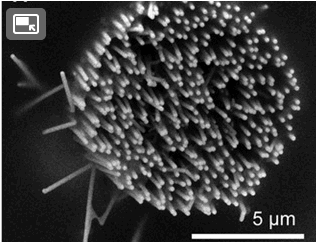
Swedish researchers can now read signals from ultrathin electrodes implanted in a living brain.
If supported by funds from President Obama’s brain study, the nanotechnology may lead to major developments in treating neural conditions.
For the first time, researchers have been able to read neural signals from ultrathin nanowire electrodes implanted in a living brain.
Electrode implants have been used to treat diseases like Parkinson’s disease for years, but their use has been limited by their relatively bulky size. As thin as hairs, existing metal electrodes are still invasive to brain tissue and can only record from one neuron at a time.
Neuroscientists at Lund University in Sweden announced in PLOS One this week that they have collaborated with experts in nanotechnology and electrical engineering to develop a nanowire electrode prototype, with each nanowire in the device measuring only 200 nanometers (billionths of a meter) in diameter.
Ultrathin electrodes like this have previously been used only in cell culture experiments, but the Swedish scientists were able to implant one in the brain of a laboratory rat.
“Carrying out experiments on a living animal is much more difficult. We are pleased that we have succeeded in developing a functioning nano-electrode, getting it into place and capturing signals from nerve cells,” said Professor Jens Schouenborg, the head of Lund University’s Neuronano Research Centre.
For years, the research group has attempted to develop electrodes that are thin and flexible enough not to disturb brain tissue, and with material that does not irritate nearby cells. This is the first evidence that it is possible to obtain useful nerve signals from nanometer-sized electrodes.
With this discovery under their belt, the researchers plan to further hone the technology.
“In the future, we hope to be able to make electrodes with nanostructured surfaces that are adapted to the various parts of the nerve cells — parts that are no bigger than a few billionths of a metre. Then we could tailor-make each electrode based on where it is going to be placed and what signals it is to capture or emit,” says Dr. Schouenborg.
If miniature electrodes can conform well enough to the brain’s surface, neurons can be monitored on a long-term basis and potentially reveal a great deal about the mechanisms involved in pain, learning, and other brain processes. Eventually, they may help treat conditions such as chronic pain, depression and Parkinson’s disease.
The Latest on: Nanowire Implants
[google_news title=”” keyword=”Nanowire Implants” num_posts=”10″ blurb_length=”0″ show_thumb=”left”]
via Google News
The Latest on: Nanowire Implants
- Feed has no items.
via Bing News










